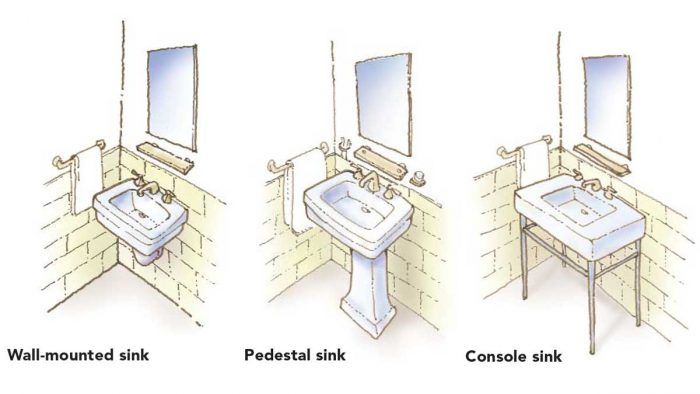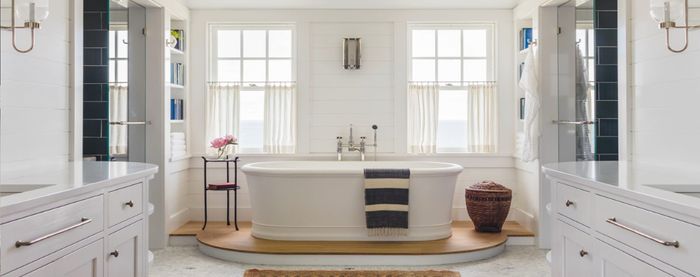Sink Choices for Small Bathrooms
Standalone sinks can be a smart choice in small spaces, even though they lack the storage afforded by vanity cabinets.

Synopsis: This article highlights the advantages of using stand-alone sinks, rather than one adjoined to a vanity cabinet, in small bathrooms. Pedestal, console, and wall-mounted sinks can free up a lot of space and make your bathroom feel bigger. Learn how to compensate for the lack of counter space without feeling compromised, and read our guidelines for placing wall-mounted storage accessories and utilities to maximize accessibility and style.
When choosing a sink for a small bathroom, you’re faced with a dizzying array of choices: self-rimming, undermount, bowl on top of a counter, pedestal. The list seems endless, and each type has its advantages. But all these sinks can be divided into two categories: those that stand alone, such as wall-mounted, pedestal, or console lavatories; and those that are part of a vanity cabinet. In spite of its integral storage, a vanity is not usually the best choice for a small bathroom.
Stand-alone sinks make small rooms bigger
Although many of my clients like the way pedestal, console, and wall-mounted sinks look, they’re concerned because these lavatories don’t provide any storage. But think about the kind of storage that a small vanity offers: Most of the cabinet is filled with drainpipes, supply lines, and the underside of the sink. The only available storage surrounds these sweaty, awkward invaders from above. There isn’t room for a shelf, so everything sits on the bottom of the cabinet. And typically, things get lost in the back.
Most items stored in a vanity are relatively small: shampoo, shaving cream, extra rolls of toilet paper, hair dryers. This paraphernalia can be stored more conveniently on shelves and in wall-mounted cabinets. A shallow storage cabinet that has been hung above the toilet or inset into an adjacent wall is more useful and space-efficient than a larger vanity cabinet. And the combined cost of a stand-alone lavatory and small storage cabinet is generally less than the total cost of a component sink, vanity cabinet, and countertop (especially if the countertop is made of stone or a solid-surface material). Wall-mounted toothbrush, tumbler, and soap holders also can be used with a stand-alone lavatory, making a vanity cabinet unnecessary.
When they are combined with the appropriate storage options, wall-mounted, pedestal, and console lavatories are excellent choices for use in small bathrooms. The open area below and around the sink makes the room feel less crowded, and the freedup wall space creates more room for hanging towel bars.
Stand-alone sinks are a better use of spaceBecause they take up less space, stand-alone sinks make a bathroom feel bigger while freeing up space for a towel bar and a shelf. Other wall-mounted accessories create more useful storage and a better-looking wall. |
Well-placed accessories let small spaces work harder
For a small sink to work best, mirrors, shelves, and lighting need to be placed comfortably. To get the details right, it’s a good idea to make a scale drawing of the area. My example gives an idea of dimensions, but you should base the actual dimensions both on the fixtures that you are going to use and on the height of your family members.
Mirrors should allow users to see their entire face and neck. This usually puts the bottom of the mirror a little more than 48 in. above the floor, or about 18 in. above the sink. Recessed medicine cabinets with mirrors provide terrific storage for toiletries and don’t take any space from a small room, but placement should be considered carefully in conjunction with any above-the-sink shelf. The shelf needs to be high enough so that you can control the faucet, but low enough so that you can open the medicine cabinet’s door without knocking things off the shelf. Taking this into consideration, I usually place the shelf about 4 in. to 6 in. below the bottom of the medicine cabinet and approximately 10 in. to 12 in. above the sink.
Speaking of mirrors, it is best to provide even, diffuse light on each side of the mirror. A light fixture can be mounted above the mirror, but used alone it will cast shadows that are particularly problematic when shaving or applying makeup (see FHB #127, “A Look at Bathroom Lighting”). Balancing lights on each side of the mirror with an overhead light that shines down behind the person at the mirror is a good idea. The ceiling fixture will provide flattering back-lighting as well as overall room illumination.
Help the space achieve its full potential, attractivelyWall-mounted storage accessories provide the utility needed, but don’t forget about placement: The height of the mirror and shelf affects their usefulness. Cabinets, fixtures, and accessories look best when centered with each other vertically and horizontally. |
Large bathrooms can afford large vanity cabinets
A vanity that combines a cabinet, countertop, and sink to create a large assembly fits more comfortably in a large bathroom. The most common type of vanity is a cabinet style similar to what you would find in a kitchen. It has a toe-kick and looks best when fit between two walls. Another attractive choice is a vanity that looks like a piece of furniture with sides that are finished as carefully as the front. Frequently, the cabinet will have legs instead of a toe-kick.
Because of their marginal storage space, vanities are most useful when they’re wide enough to allow drawers flanking the sink. A 48-in. cabinet is the minimum to fit a sink in the center with drawers on each side.
Three ways to make a small bathroom biggerStand-alone sinks come in many forms, but wall-mounted, pedestal, and console are the most common. They’re visually less imposing than boxy vanity cabinets and are more functional. |
Architect Lynn Hopkins lives with her husband and two daughters in Lexington, Mass.
Drawings: Lynn Hopkins
From Fine Homebuilding #164
Fine Homebuilding Recommended Products
Fine Homebuilding receives a commission for items purchased through links on this site, including Amazon Associates and other affiliate advertising programs.

A Field Guide to American Houses

Get Your House Right: Architectural Elements to Use & Avoid

All New Kitchen Ideas that Work








